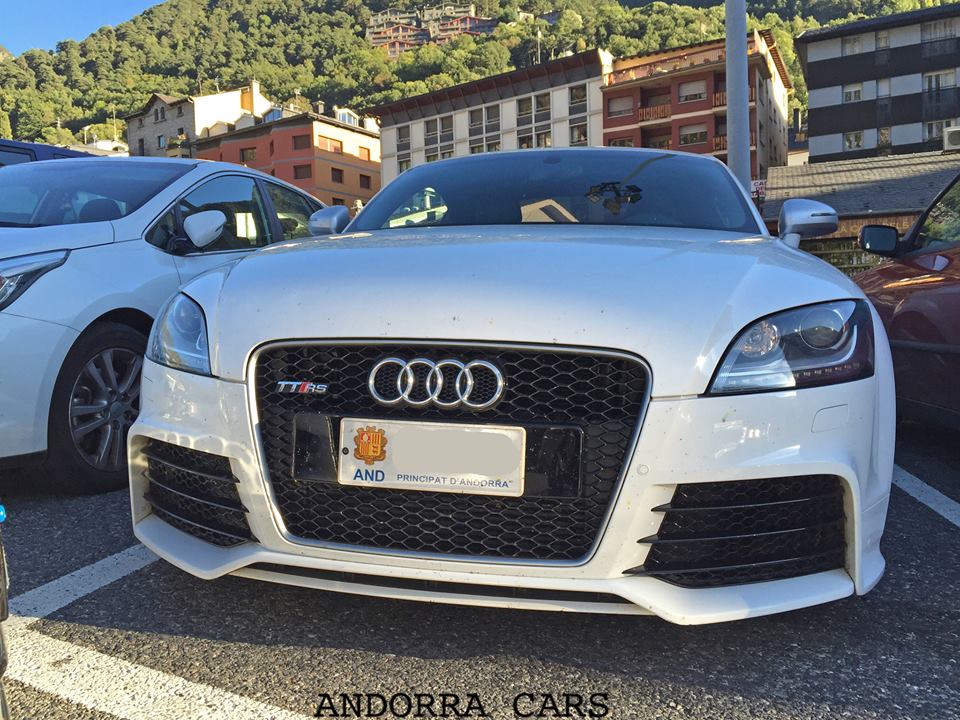Audi TT RS. White color 335 bhp
With its world debut at the 2009 Geneva Auto Show, and developed by Audi’s high-performance subsidiary quattro GmbH at Neckarsulm, Germany, Audi released the first ever compact sports car Audi “RS” variant – the Audi TT RS, which was available from 2009 in Coupé and Roadster variants. The TT RS featured an all-new 2.5-litre Inline-5 turbocharged petrol engine. This new 183 kg (403 lb) engine produces a DIN-rated power output of 250 kW (340 PS; 335 bhp) from 5,400 to 6,700 rpm, and torque of 450 N⋅m (332 lbf⋅ft) at 1,600–5,300 rpm.
Ever since the original Audi “RS” model – the Audi RS2 Avant – all Audi “RS” models were assembled at the quattro GmbH factory in Neckarsulm. The TT RS is the first Audi RS vehicle that didn’t have any of its assembly performed in Neckarsulm but was completely assembled in the Audi factory in Győr, Hungary, alongside the base Audi TT.
The TT RS has a new short-shift close-ratio six-speed manual transmission, and like all “RS” models, is only available with four-wheel-drive, with the TT RS using a specially adapted version of the latest generation multi-plate clutch from Haldex Traction. Additions to the quattro system include a constant velocity joint before the cardan propeller shaft, and a compact rear-axle differential – upgraded to cope with the increased torque from the five-cylinder turbo engine.
Like the TTS, the TT RS has a 10 millimetres (0.4 in) lower ride height, optional “Audi Magnetic Ride”, and rides on standard 18-inch wheels with 245/45 ZR18 tyres (optional 19″ or 20″ wheels are also available). The brakes are upgraded to include two-piece cross-drilled and radially vented front discs, sized at 370 mm (14.6 in) in diameter. The front discs are clamped by gloss black painted four-piston calipers, adorned with the RS logo. Rear ventilated discs are sized at 310 mm (12.2 in) in diameter.
It includes a fixed rear spoiler (retractable optional), and has black interior with heated Alcantara/leather sports seats (Silk Nappa, Fine Nappa leather optional).
The Recaro “RS bucket” seats, first seen in the Audi B7 RS4 are also available as an option. Also carried over from the B7 RS4 is the “Sport” button, which sharpens the throttle response and deepens the exhaust note, and a three-stage user-selectable Electronic Stability Programme (ESP).
Official performance figures indicate the TT RS Coupé will accelerate from a standstill to 100 km/h (62.1 mph) in 4.5 seconds (4.7 seconds for the Roadster), with an electronically limited top speed of 250 km/h (155 mph).
There is a factory option to de-restrict the top speed to 280 km/h (174.0 mph). The Coupé has a kerb weight of 1,450 kg (3,197 lb), and the Roadster weighs in at 1,510 kg (3,329 lb).
As of 2010 the TT-RS is available with the 7-speed DSG automatic transmission capable of handling the torque delivered by the engine. The 6-speed gearbox used in the TT-S cannot cope with 450 N⋅m (332 lbf⋅ft) which is why the TT-RS initially was offered only with a manual transmission.
The car went on sale in March 2009, with delivery beginning in summer.
In 2010, the TT-RS was confirmed for the US market. The decision was influenced by an internet petition to bring the TT-RS stateside, which succeeded with over 11,000 signatures. The TT-RS arrived in Q3 2011 as a 2012 model.
In 2012, the TT RS plus was launched. It featured the uprated version of the TT RS’ engine that had originally been developed for the RS Q3 concept car; this version of the engine produces 355 hp (265 kW; 360 PS) at 5500 rpm, and 343 lb⋅ft (465 N⋅m) of torque at 1650 rpm.
As a result of this power increase, Audi claimed that the 0-62 mph (100 km/h) time had decreased to 4.3 seconds for the manual version, and 4.1 seconds for the S-tronic version.
In addition to this, Audi raised the top speed limiter, with the TT RS plus being restricted to 174 mph (280 km/h).












